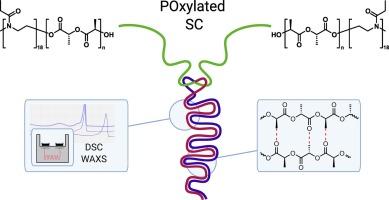来自 PEtOx-b-PLA 二嵌段共聚物的 POxylated 立体共聚物
IF 5.8
2区 化学
Q1 POLYMER SCIENCE
引用次数: 0
摘要
通过乙酸酯终止 2-乙基-2-噁唑啉的阳离子开环聚合,然后用甲醇进行酯交换反应,得到了一种ω-羟基端聚合(2-乙基-2-噁唑啉)(PEtOx)。生成的 PEtOx-OH 聚合度(DP)为 18,可用作 l-内酰胺和 d-内酰胺开环聚合的大引发剂。得到的 PEtOx-b-PLA 嵌段共聚物的 DP 值分别为 25、50、100 和 150,并通过尺寸排阻色谱法、1H NMR 光谱法和基质辅助激光解吸电离质谱法进行了表征。差示扫描量热法、广角 X 射线散射法和偏光显微镜表明,在具有相反手性的 PEtOx-b-PLA 外消旋混合物中形成了立体络合物。因此,与聚乳酸均聚物立体络合物的数据相比,无定形的 PEtOx 嵌段并不影响立体络合物晶体的修饰。与上述数据类似,在 PEtOx-b-PLA 嵌段共聚物形成的立体共聚物中,结晶度和熔化温度随聚乳酸摩尔质量的增加而降低。本文章由计算机程序翻译,如有差异,请以英文原文为准。

POxylated stereocomplexes from PEtOx-b-PLA diblock copolymers
An ω-hydroxyl terminated poly(2-ethyl-2-oxazoline) (PEtOx) was obtained by termination of the cationic ring-opening polymerization of 2-ethyl-2-oxazoline with acetate and subsequent transesterification with methanol. The resulting PEtOx-OH featuring a degree of polymerization (DP) of 18 was used as a macroinitiator for the ring-opening polymerization of l-lactide as well as d-lactide. The resulting PEtOx-b-PLA block copolymers featured DP values of 25, 50, 100, and 150, respectively, and were characterized by means of size exclusion chromatography, 1H NMR spectroscopy as well as matrix-assisted laser desorption ionization mass spectrometry. Differential scanning calorimetry, wide-angle x-ray scattering and polarized light microscopy indicated the formation of stereocomplexes in racemic blends of PEtOx-b-PLA with opposing chirality. Thereby, the amorphous PEtOx block did not affect the modification of the stereocomplex crystallites, as shown by comparison with data obtained from PLA homopolymer stereocomplexes. Similar to those, the degree of crystallinity and melting temperature decreased with increasing molar mass of the PLA in the stereocomplexes formed from PEtOx-b-PLA block copolymers.
求助全文
通过发布文献求助,成功后即可免费获取论文全文。
去求助
来源期刊

European Polymer Journal
化学-高分子科学
CiteScore
9.90
自引率
10.00%
发文量
691
审稿时长
23 days
期刊介绍:
European Polymer Journal is dedicated to publishing work on fundamental and applied polymer chemistry and macromolecular materials. The journal covers all aspects of polymer synthesis, including polymerization mechanisms and chemical functional transformations, with a focus on novel polymers and the relationships between molecular structure and polymer properties. In addition, we welcome submissions on bio-based or renewable polymers, stimuli-responsive systems and polymer bio-hybrids. European Polymer Journal also publishes research on the biomedical application of polymers, including drug delivery and regenerative medicine. The main scope is covered but not limited to the following core research areas:
Polymer synthesis and functionalization
• Novel synthetic routes for polymerization, functional modification, controlled/living polymerization and precision polymers.
Stimuli-responsive polymers
• Including shape memory and self-healing polymers.
Supramolecular polymers and self-assembly
• Molecular recognition and higher order polymer structures.
Renewable and sustainable polymers
• Bio-based, biodegradable and anti-microbial polymers and polymeric bio-nanocomposites.
Polymers at interfaces and surfaces
• Chemistry and engineering of surfaces with biological relevance, including patterning, antifouling polymers and polymers for membrane applications.
Biomedical applications and nanomedicine
• Polymers for regenerative medicine, drug delivery molecular release and gene therapy
The scope of European Polymer Journal no longer includes Polymer Physics.
 求助内容:
求助内容: 应助结果提醒方式:
应助结果提醒方式:


